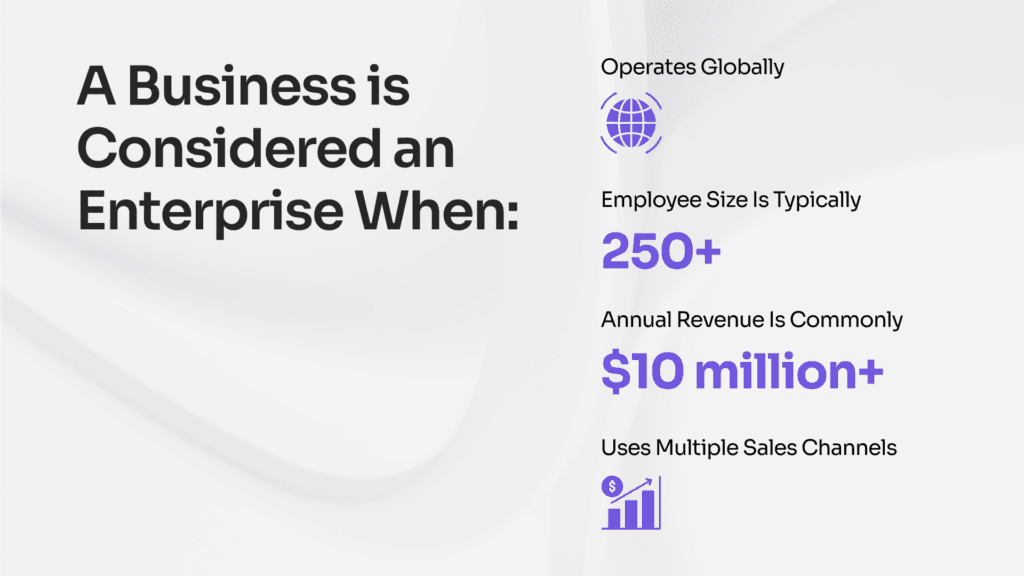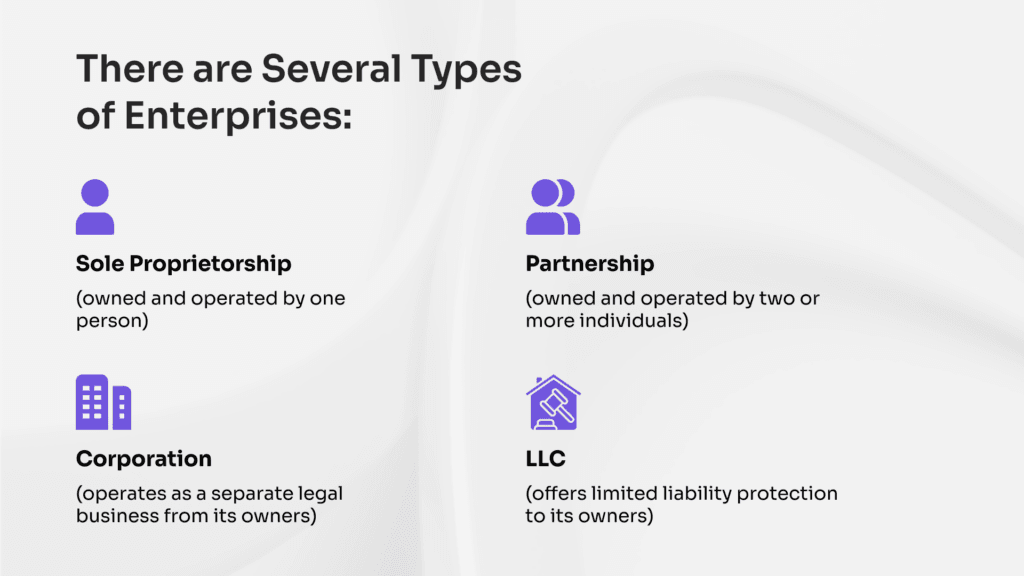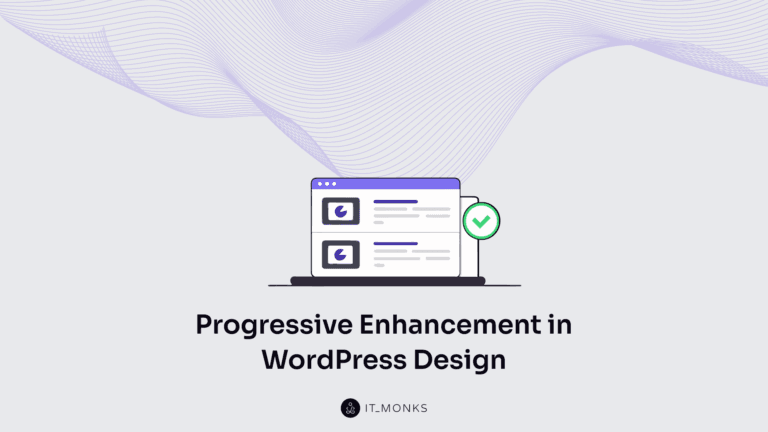What is Enterprise Business?
Table of Contents

An enterprise business is a large-scale organization engaged in commercial, industrial, or professional activities. It typically operates with numerous divisions and departments, each focusing on specialized functions and managed by an executive leadership team or board of directors.
Enterprise businesses feature a sizable workforce and diverse products and services and often operate across international markets. Managed by executive teams, they may sell directly to consumers (direct-to-consumer), serve other businesses (business-to-business), or both.
Large-scale businesses rely on automation and scalable systems to drive growth, while strong security and seamless data integration ensure efficiency and privacy.
Enterprise organizations need well-crafted websites for customer interaction, showcasing offerings, and building brand credibility. Professional website development services are essential for creating user-friendly, visually appealing sites tailored to large-scale businesses.
This guide goes beyond explaining the meaning of an enterprise in business. We dive deeper into discussing the difference between an enterprise and a small business and major enterprise types. Besides, we discuss the role of technology and digital presence importance for an enterprise.
What Makes a Business an Enterprise?

A business is considered an enterprise company when it operates on a large scale, typically with over 250 employees, has a complex structure with multiple departments, and holds a significant market presence, often with annual revenues starting at $10 million and potentially exceeding $1 billion.
Enterprises are characterized by their complexity. They have multiple specialized departments, such as marketing, production, and finance, and often manage operations across various markets simultaneously. Their legal entity status allows them to own assets independently, enter contracts, and incur liabilities.
An enterprise’s ability to operate internationally and leverage multiple sales channels further underscores its scale.
Examples of enterprises include global giants like Amazon, Google, and Coca-Cola.
Employee Size
Employee size is a key criterion for defining enterprise businesses, typically referring to large organizations with over 250 employees, often spread across multiple locations and markets.
In the European Union, this threshold of 250 employees is used to classify enterprises, with no specific revenue requirements, while in the United States, there are no standardized benchmarks for either employee size or revenue, making the classification more flexible.
Businesses are also classified by size as follows:
- Micro-enterprises: 1–9 employees
- Small enterprises: 10–49 employees
- Medium-sized enterprises: 50–249 employees
- Large enterprises: 250 or more employees
Revenue (Capital)
Enterprises typically generate annual revenues ranging from $10 million to over $1 billion. While there is no fixed revenue cutoff, these figures help distinguish enterprises from smaller businesses.
Revenue levels can vary significantly by industry. Enterprises in sectors like technology, finance, and manufacturing often reach higher thresholds due to the scale of their operations and global reach.
Complexity of Business Structure
The complexity of an enterprise business structure lies in its size, scope, and organizational framework. Enterprises often operate globally with multiple locations and diverse operations across regions.
Their internal structures typically comprise numerous departments and divisions, including marketing, finance, production, and human resources, each with specialized functions.
Common business structures include sole proprietorships, partnerships, corporations, and LLCs.
International Scale
An enterprise business often operates locally, providing the goods or services in one country, or internationally, conducting activities across multiple countries and reaching customers and markets worldwide. Their operations span diverse markets, involving selling products or services tailored to different customer bases.
Managing an international enterprise requires navigating various challenges, including compliance with local regulations, handling multiple currencies, addressing cultural differences, and coordinating complex logistics.
Multiple Sales Channels
An enterprise business uses multiple sales channels to reach customers through various platforms, combining physical and digital avenues. These businesses sell their products or services via enterprise websites, physical stores, online marketplaces like Amazon, social media platforms, and mobile apps.
Enterprise businesses often adopt an omnichannel strategy, ensuring a seamless experience across all channels. For example, customers receive consistent product information and inventory availability whether shopping online, in-store, or via a mobile app.
Enterprise Companies Examples
Enterprise companies exemplify scale and complexity, as seen with Ford, Microsoft, Walmart, Exxon, Apple, and Amazon.
- Ford Motor Company employs around 175,000 people globally and generates $182.743 billion in annual revenue. With over 65 plants worldwide, Ford operates on six continents and uses diverse sales channels, such as retail, fleet, and distribution networks.
- Microsoft has 228,000 employees, with 126,000 in the U.S. and 102,000 internationally. The company’s 2024 revenue reached $245.12 billion, supported by its partner ecosystem, Microsoft Stores, and third-party retailers.
- Walmart has a massive workforce of 2.1 million associates globally, including 1.6 million in the U.S., and a 2024 fiscal revenue of $648 billion, showcasing its vast retail dominance.
- Exxon Mobil employs 62,000 individuals across 60 countries and posted a revenue of $350.50 billion in 2024. Its decentralized structure and segmented leadership facilitate agile operations in the energy sector.
- Apple, with a workforce of 164,000, generated $391.04 billion in revenue in 2024. Known for its functional organizational structure, Apple utilizes online and offline channels, including Apple Stores, telecom providers, and authorized resellers like Amazon.
- Amazon, with 1.55 million employees, achieved revenue of $620.12 billion in 2024. Its hierarchical structure enables efficient management of its expansive e-commerce, cloud computing, and logistics operations.
What is the Difference between Enterprise Business and Small Business?
The key differences between enterprise and small businesses lie in size, operational complexity, and market reach.
An enterprise business is a large-scale organization with significant complexity and global reach. In contrast, a small business is a smaller, localized organization with a simpler structure and fewer resources.
- Enterprise businesses like Amazon or Walmart have millions of employees and annual revenues exceeding $600 billion. Small businesses, by comparison, typically have fewer than 50 employees and generate significantly less revenue, often below $10 million annually.
- Enterprises are structured with multiple departments, divisions, and locations. For example, Ford operates 65 plants across six continents and employs 175,000 people. Small businesses usually have simpler hierarchies with minimal management layers.
- Enterprise businesses operate internationally, reaching customers in multiple countries. For example, Microsoft’s ecosystem spans retail stores, online platforms, and partnerships worldwide. Small businesses often serve a local or niche market, focusing on a specific customer base.
- Enterprises access extensive resources, including capital, technology, and workforce. Companies like Apple, with $391 billion in annual revenue, exemplify this capability. Small businesses, on the other hand, often operate with limited resources and rely on personal investments or small loans.
What Are the Enterprise Types?

Enterprise types are sole proprietorship, partnership, corporation, and limited liability company (LLC). These types define how a business is owned, managed, and taxed, offering different benefits and responsibilities to its owners.
Sole proprietorship
A sole proprietorship is a business owned and operated by a single individual. It is the simplest type of enterprise, with no legal distinction between the owner and the business. The owner is personally liable for all debts and obligations.
This structure is easy to establish and typically requires minimal formalities. The owner controls all business decisions, operations, and profits. Common examples include manufacturing-based businesses, personal trainers, small landscaping businesses, etc.
Partnership
A partnership is a type of business enterprise in which two or more individuals share ownership and operations. Different types include general, limited, and limited liability partnerships. The owners share profits, losses, and management responsibilities in a partnership.
Partners have a pass-through tax structure, meaning the business doesn’t pay income tax. Instead, profits and losses pass through to the individual partners.
A partnership agreement outlines how profits, losses, and responsibilities are shared and defines each partner’s liability.
Well-known examples of business partnerships include Google (co-founded by Larry Page and Sergey Brin, who met at Stanford University) and Ben & Jerry’s (founded by Ben Cohen and Jerry Greenfield, childhood friends).
Corporation
A corporation is a large, complex enterprise type that operates as a separate legal business from its owners. This means the corporation has its own rights and responsibilities and can be sued independently of its shareholders.
The structure often includes multiple divisions, subsidiaries, and a board of directors managing the company.
Corporations are typically large-scale organizations with significant reach in multiple markets or industries. They provide liability protection for their owners, meaning shareholders are not personally responsible for business debts. Companies like Apple, Microsoft, and Walmart are examples of corporations with vast operations.
Limited Liability Company (LLC)
A Limited Liability Company (LLC) is a type of business enterprise that combines a partnership’s flexibility with a corporation’s legal protection. Owners, known as members, enjoy limited liability, meaning their assets are protected from business debts.
Additionally, LLCs benefit from pass-through taxation, where business profits and losses are reported on the owners’ tax returns, avoiding corporate tax rates.
The main advantage of an LLC is that it shields owners from personal liability for business debts. LLCs can have multiple owners or just a single member. They also provide flexibility in management, with fewer formalities compared to corporations.
What is the Role of Technology in Enterprise Business?
The role of technology in enterprise business is to streamline operations, enhance efficiency, and drive growth. With the internet, websites, and cloud platforms, enterprise businesses can efficiently manage large data sets, scale rapidly, and reach a global market.
Technology also supports decision-making and team collaboration, ultimately improving overall business performance.
Technology in enterprise businesses covers tasks like customer relationship management (CRM), data analytics, and process automation. It also aids in supply chain management, cybersecurity, and financial management.
For example, cloud computing provides flexible resource access, while tools like enterprise resource planning (ERP) integrate various business functions. AI, IoT, and big data analytics are crucial for optimizing operations and enhancing customer experiences.
Importance of a Digital Presence for Enterprise Businesses
A website is crucial for enterprise businesses because it is a central platform for engaging with customers, managing internal operations, scaling business processes, and integrating technology into business processes.
- A website enables direct customer interaction, offering contact forms, live chats, and support features to resolve queries and maintain strong relationships. It also allows businesses to share important updates and product information and engage in marketing campaigns.
- A website automates order management, customer support, and service requests. This streamlines operations and ensures smooth day-to-day business functions.
- As enterprises grow, their data and processes need to scale as well. A well-designed website accommodates growing volumes of transactions, data, and customer interactions, ensuring the business can expand without disrupting service.
- A website can seamlessly integrate various tools and systems, like CRM platforms, e-commerce solutions, and analytics, to improve overall business processes and decision-making.
A strong digital presence for enterprises is built through web development, ensuring websites are scalable, secure, and capable of supporting growth and efficiency.
What is Enterprise Website Development?
Enterprise website development is the process of creating and managing websites designed for large businesses. These websites handle high traffic, support complex operations, and integrate advanced tools.
They require specialized expertise in areas like backend architecture, cybersecurity, and seamless systems integration to ensure reliable functionality and support the organization’s growth.
Most enterprise websites are dynamic platforms that integrate various applications and specialized software necessary for efficient management, such as Customer Relationship Management (CRM) systems, Enterprise Resource Planning (ERP) software, Content Management Systems (CMS), Payment Gateways, etc.
Developing an enterprise website includes key solutions like website design, SEO, marketing, enterprise apps, enterprise software, and more. Each solution requires specific tools and technologies to maximize performance and competitiveness.
Depending on the project scope, customization, and the software required, enterprise website development typically costs from $50,000 to $500,000 or more.
The process of developing a website for a large-scale business is a multi-faceted endeavor that requires thorough planning and specialized expertise. Our guide on enterprise web development provides essential insights to navigate this complex process effectively.
Key Features of Enterprise Websites
The key features of enterprise websites include handling complex tasks, such as acting as a central hub, managing large data flows, integrating complex software, handling high traffic, and reinforcing brand identity.
Thus, an enterprise website is an online site that:
- operates as a central hub by connecting internal and external systems, enabling users to easily navigate and access data across departments;
- manages a significant volume of data flowing in and out, often from multiple sources;
- integrates complex software, enabling different applications and systems to work seamlessly on the website;
- manages high traffic with strategies like strong server infrastructure, CDNs, and load balancing to maintain performance;
- reflects the company’s values and vision while providing a seamless and engaging user experience.
Implementing all essential enterprise features with expert enterprise website development solutions is more efficient, ensuring the website seamlessly integrates advanced technologies that align with organizational objectives.
How Does Enterprise Website Development Support Enterprise Goals?
Enterprise website development supports business goals by focusing on efficient integration, scalability, and enhanced data management.
Developers enable seamless communication between various systems, such as CRM, ERP, and payment gateways.
Developers design websites with flexible infrastructure that grows with the business. They optimize performance to handle increased traffic and ensure the site remains functional during high demand. Auto-scaling, cloud hosting, and CDNs allow the website to adapt to growing business needs.
Enhanced data management is also critical. Developers build systems that handle large volumes of data securely and efficiently. They ensure customer, inventory, and business data is well-organized and accessible. Implementing robust security and backup protocols protects sensitive information while allowing businesses to make data-driven decisions.
Contact
Don't like forms?
Shoot us an email at [email protected]

Send a Project Brief
You need to load content from reCAPTCHA to submit the form. Please note that doing so will share data with third-party providers.
More InformationYou are currently viewing a placeholder content from Turnstile. To access the actual content, click the button below. Please note that doing so will share data with third-party providers.
More InformationYou are currently viewing a placeholder content from Facebook. To access the actual content, click the button below. Please note that doing so will share data with third-party providers.
More InformationYou are currently viewing a placeholder content from Instagram. To access the actual content, click the button below. Please note that doing so will share data with third-party providers.
More InformationYou are currently viewing a placeholder content from X. To access the actual content, click the button below. Please note that doing so will share data with third-party providers.
More Information


